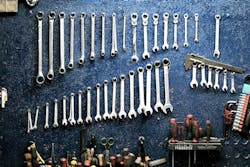SHOP STATS: Little Wolf Auto Repair Location: Waupaca, Wisc. Operator: Scott Bickley Average Monthly Car Count: 750 (quick lube), 200 (auto repair) Total Staff Size: 14 Shop Size: 2,000 sq. ft. (quick lube), 5,000 sq. ft. (auto repair) Total Annual Revenue: $1.9 million
Shop preference can be a matter of taste. In the food business, that's in the literal sense. For example, you’re looking for a place to eat. You see two options in your view: one is a burger joint with signage that looked to come from the early 80s, paint stripped on the walls, and washed-up employees through the window; the other option is a pizza place. The sign looks fresh, the wood siding has a clean look, and the parking lot is spotless; even the employees look clean-cut and happy to be there. What sounds tastier now?
What some operators don’t realize is that the overall appearance can affect customer choices, and it all starts with the outside.
When Scott Bickley, owner of Little Wolf Auto Repair in Waupaca, Wis., was looking to relocate his repair shop next to his quick lube, he knew the importance of first impressions.
But as an operator, he had other factors to consider. The new building had to complement the existing quick lube shop. It had to be functional for his staff and techs. And to get the project done, it had to be economical.
Scott Rider, owner of Texas-based Rider Construction, has helped operators through these decisions. He spent 30 years in the quick lube business before moving to the construction side for quick lubes in 2012.
As Bickley shares his strategy for a successful build, Rider helps to put the process in perspective for any operator looking at a major project.
The Question: What are the goals?
Rider says quick lubes need to partner with a construction company that understands the business. Find the right balance between the fashion and function of a building.
“What you need to have is an experienced construction company that can add economical upgrades that give it a new look and make sure you don’t spend a fortune,” Rider says.
According to Rider, it’s important to have a consistent brand image, whether you run one store, five or 100.
The Result:
Little Wolf’s Auto Repair and its quick lube were 16 miles apart. According to Bickley, more than 50 percent of work was coming from the quick lube, mainly thanks to a good location. So when 6.5 acres became available just 100 yards from the quick lube, Bickley jumped on the opportunity.
The shop could have just moved into a new building closer to the quick lube, but Bickley says nothing was comparable in efficiency. Even with renovating an existing location, moving walls and adding on was going to be more expensive than building a location to their liking.
Bickley worked the numbers. He looked at what the total payment was going to be and determined where the shop needed to be for car count and its ARO. He even consulted his 20 group and shared the shop’s numbers to get an extra helping hand.
That’s a valuable resource, Rider says.
“Across the country, people are always helping other operators; it’s just a phone call away,” he says. “It’s kind of like a secret shopper.”
The Question: What’s the Budget?
While operators need to consider timing when renovating or building, Rider says shops should get an update every six to seven years, planning to save $25,000–$50,000, depending on the facility’s size. If you are in an extremely small market, he says you may want to spend $10,000 every five to 10 years. Double that if you’re in a medium-sized market.
“Over a 10-year period, if you budgeted $5,000 per year, you could spend some of that,” Rider says. “It doesn’t have to be done all at once. You can make a checklist for stuff that needs to be done consistently.”
The Result:
For a lot of business owners, even homeowners, it can be hard to understand the actual cost of renovation or building project. Going into it, Bickley had never underwent a big construction project like this before, so it took some learning along the way. He says the biggest thing is to understand the construction plan and the overall cost. For example, it may seem like moving some dirt around costs a couple thousand bucks, but that’s far from the reality.
“The dirt work itself was almost $100,000 just to move dirt,” Bickley says. “That’s one of the costs I didn’t understand until I got into it.”
And when taking out a construction loan, he says most builders want at leasts 10 percent down. Halfway through the project, they want a second payment, and finally one when the building is complete. Bickley says not to give the final payment until you’ve made sure everything is up and working. He didn’t make his last payment until everything was all moved in.
Throughout the construction process, changes may come up. Make sure to establish changes before any construction begins, otherwise you’ll be paying a lot of money to fix it afterward.
“It costs nothing to change on blueprint, but costs quite a bit to change after it’s completed,” Bickley says.
The Question: How Can You Join Form and Function?
Rider says it’s easy for operators to get complacent. Functionality has to meet formality—the landscaping, the trash in your parking lot and the appearance of your employees. Sometimes the customer’s vantage can get lost.
“You get a different perspective,” Rider says. “You get a snapshot of that store on that day for four to five hours for the limited time you are there. You forget about the small details.”
From his experience, he has seen both sides when it comes to the bigger picture and the day-to-day operations.
The Results:
Bickley’s overall goal was to make the shop professional looking and to present services in a professional manner throughout.
Since Bickley came from the dealership background, he wanted this same look—classy and professional. Bickley says he stayed away from metal siding—he didn’t want the shop to look like a machine shed. Instead, he used a wood siding. Three feet of brick was then lined all around the front, along with a lot of glass and tile in order to showcase more professionalism.
It was also about efficiency. Operators should have a list of the qualities they want in a building and find out what’s possible within a budget. Bickley searched high and low for an existing space that fit this need, but nothing added up.
“I could have gotten a bigger building, but the efficiency of the building wasn’t there,” he says.
Overall, building from scratch made financial sense. Instead of working with an existing building to tear down walls and add on space, he could start from scratch and create exactly what he wanted.
The Ultimate Outcome
With the move to the bigger market and the entire shop renovation, Bickley says the quick lube created enough work that kept the full-service shop busy. The repair shop’s average repair order went from $350–$700, and the quick lube’s ticket average went up, too—from $65 to $78—by offering extra services and on-demand tire installations.
“It gave us an outlet to do more auto repairs,” Bickley says.
Bickley says there are two things he might have done differently: increase his level of research and hire a lawyer. Because he came in new to the process, he had a lot of learning to do along the way. He suggests visiting other shops that went under a construction project and talk to them about the process they went through. He says he could have avoided a lot of assumptions and hidden costs. This is also the reason he wishes he hired a lawyer.
“The city will convince you to do stuff that sometimes you don’t need to do,” Bickley says. “I recommend having a lawyer handy to review documents to help.”





